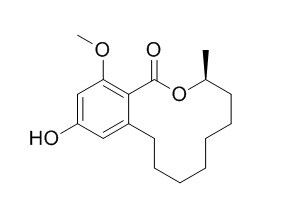Lasiodiplodin
Lasiodiplodin may have potential anti-inflammatory activity, it shows moderate suppression effects on induced NO production. Lasiodiplodin inhibits electron transport chain.
Inquire / Order:
manager@chemfaces.com
Technical Inquiries:
service@chemfaces.com
Tel:
+86-27-84237783
Fax:
+86-27-84254680
Address:
1 Building, No. 83, CheCheng Rd., Wuhan Economic and Technological Development Zone, Wuhan, Hubei 430056, PRC
Providing storage is as stated on the product vial and the vial is kept tightly sealed, the product can be stored for up to
24 months(2-8C).
Wherever possible, you should prepare and use solutions on the same day. However, if you need to make up stock solutions in advance, we recommend that you store the solution as aliquots in tightly sealed vials at -20C. Generally, these will be useable for up to two weeks. Before use, and prior to opening the vial we recommend that you allow your product to equilibrate to room temperature for at least 1 hour.
Need more advice on solubility, usage and handling? Please email to: service@chemfaces.com
The packaging of the product may have turned upside down during transportation, resulting in the natural compounds adhering to the neck or cap of the vial. take the vial out of its packaging and gently shake to let the compounds fall to the bottom of the vial. for liquid products, centrifuge at 200-500 RPM to gather the liquid at the bottom of the vial. try to avoid loss or contamination during handling.
Molecules.2021, 26(9):2802.
Talanta.2022, 249:123645.
Plant Sci.2021, 313:111069.
Food Chem.2024, 446:138870.
Phytother Res.2019, 33(5):1490-1500
Sci Rep.2017, 7:40345
Cell Death Dis.2019, 10(12):882
J Food Sci.2024, 3841.17112.
Food Chem.2023, 424:136383.
The Journal of Korean Medicine2023, 44(4):26-40.
Related and Featured Products
J Agric Food Chem. 2007 May 16;55(10):4217-21.
Inhibition of photophosphorylation and electron transport chain in thylakoids by lasiodiplodin, a natural product from Botryosphaeria rhodina.[Pubmed:
17432876]
Four natural products were isolated from the fungus Botryosphaeria rhodina, and their effects on photosynthesis were tested.
METHODS AND RESULTS:
Only Lasiodiplodin (1) inhibited ATP synthesis and electron flow from water to methylviologen; therefore, it acts as a Hill reaction inhibitor in freshly lysed spinach thylakoids. Photosystem I and II and partial reactions as well as ATPase were measured in the presence of 1.
CONCLUSIONS:
Three new different sites of 1 interaction and inhibition were found: one at CF1, the second in the water-splitting enzyme, and the third at the electron-transfer path between P680 and QA; these targets are different from that of the synthetic herbicides present. Electron transport chain inhibition by 1 was corroborated by fluorescence induction kinetics studies.
Evid Based Complement Alternat Med. 2015;2015:602425.
Inhibitory Effects of Chemical Compounds Isolated from the Rhizome of Smilax glabra on Nitric Oxide and Tumor Necrosis Factor- α Production in Lipopolysaccharide-Induced RAW264.7 Cell.[Pubmed:
25821492 ]
The rhizome of Smilax glabra has been used for a long time as both food and folk medicine in many countries.
METHODS AND RESULTS:
The present study focused on the active constituents from the rhizome of S. glabra, which possess potential anti-inflammatory activities. As a result, nine known compounds were isolated from the rhizome of S. glabra with the bioassay-guiding, and were identified as syringaresinol (1), Lasiodiplodin (2), de-O-methylLasiodiplodin (3), syringic acid (4), 1,4-bis(4-hydroxy-3,5-dimethoxyphenyl)-2,3-bis(hydroxymethyl)-1,4-butanediol (5), lyoniresinol (6), trans-resveratrol (7), trans-caffeic acid methyl ester (8), and dihydrokaempferol (9). Among these compounds, 2 and 3 were isolated for the first time from S. glabra. In addition, the potential anti-inflammatory activities of the isolated compounds were evaluated in vitro in lipopolysaccharide- (LPS-) induced RAW264.7 cells. Results indicated that 4 and 7 showed significant inhibitory effects on NO production of RAW264.7 cells, and 1, 2, 3, and 5 showed moderate suppression effects on induced NO production. 1, 7, and 5 exhibited high inhibitory effects on TNF-α production, with the IC50 values less than 2.3, 4.4, and 16.6 μM, respectively.
CONCLUSIONS:
These findings strongly suggest that compounds 1, 2, 3, 4, 5, 7, and 9 were the potential anti-inflammatory active compositions of S. glabra.
Bioorg Med Chem Lett. 2006 Aug 15;16(16):4205-8.
Lactones from a brown alga endophytic fungus (No. ZZF36) from the South China Sea and their antimicrobial activities.[Pubmed:
16781152 ]
METHODS AND RESULTS:
Two new metabolites named 6-oxo-de-O-methylLasiodiplodin (1) and (E)-9-etheno-Lasiodiplodin (2), with three known compounds Lasiodiplodin (3), de-O-methylLasiodiplodin (4), and 5-hydroxy-de-O-methylLasiodiplodin (5), were isolated from the mycelium extracts of a brown alga endophytic fungus (No. ZZF36) obtained from the South China Sea. Their structures were elucidated using spectroscopic methods, mainly 1D and 2D NMR. Additionally, the structure of compound 1 was confirmed by single crystal X-ray diffraction analysis.
CONCLUSIONS:
The antimicrobial activities of Lasiodiplodins, and the 13-acetyl and 12,14-dibromo derivatives of Lasiodiplodin were tested for the first time and the results were compared to each other.



